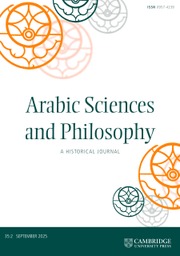Article contents
THE LOGIC OF AVICENNA BETWEEN AL-QIYĀS AND MANṬIQ AL-MAŠRIQIYYĪN
Published online by Cambridge University Press: 30 January 2019
Abstract
Avicenna's logic is presented in many treatises, of which the most important is Al-Qiyās (Prior analytics), which is included in his encyclopaedic book Al-Šifā’. But the treatise entitled Manṭiq al-mašriqiyyīn is said to express Avicenna's own logic by some commentators. One can thus ask: is this treatise in conflict with Al-Qiyās and the other logical writings? In this paper, we will answer this question by comparing Avicenna's analyses of the absolute – i. e. non modal – propositions. We will show that there is no radical difference between both treatises in this respect, since most conditions added to the absolute propositions in Al-Qiyās can be found in Manṭiq al-mašriqiyyīn. These conditions are: (1) “as long as S exists”, (2) “as long as it is S”, (3) “as long as it is P”, (4) “at some times”, (5) “at one determined time”, (6) “sometimes but not permanently”. In Manṭiq al-mašriqiyyīn, the ḍarūrīya contains (1), the lāzima contains (2), the muntašira contains (4), the mafrūḍa contains (5), the wujūdiyya contains (6), but (3) is abandoned. The waqtiyya was evoked in Al-Qiyās, although not classified. So the temporal analysis initiated in Al-Qiyās is pursued and developed in Manṭiq al-mašriqiyyīn, even if in the latter it is sometimes confused.
Résumé
La logique d'Avicenne est présentée dans plusieurs traités, dont le plus important est Al-Qiyās (Premiers analytiques), qui est inclus dans son livre encyclopédique Al-Šifā’. Mais le traité intitulé Manṭiq al-mašriqiyyīn est celui qui, selon certains commentateurs, exprime la véritable logique d'Avicenne. On peut donc poser la question suivante : ce traité est-il en conflit avec Al-Qiyās et les autres écrits d'Avicenne ? Dans cet article, nous répondrons à cette question en comparant les analyses d'Avicenne des propositions absolues, i. e. non modales. Nous montrerons qu'il n'y a pas de différence radicale entre les deux traités sur ce sujet puisque la plupart des conditions ajoutées aux propositions absolues dans Al-Qiyās peuvent être trouvées dans Manṭiq al-mašriqiyyīn. Ces conditions sont les suivantes : (1)“tant que S existe”, (2)“tant qu'il est S”, (3)“tant qu'il est P”, (4) “parfois”, (5) “à un moment déterminé”, (6) “parfois mais pas en permanence”. Dans Manṭiq al-mašriqiyyīn, la ḍarūrīya contient (1), la lāzima contient (2), la muntašira contient (4), la mafrūḍa contient (5), la wujūdiyya contient (6), mais (3) est abandonnée. La waqtiyya était évoquée dans Al-Qiyās mais sans être classifiée. L'analyse temporelle initiée dans Al-Qiyās est donc poursuivie et développée dans Manṭiq al-mašriqiyyīn, même si dans ce dernier elle est parfois confuse.
- Type
- Research Article
- Information
- Copyright
- Copyright © Cambridge University Press 2019
- 5
- Cited by


